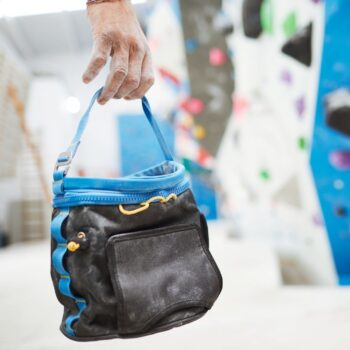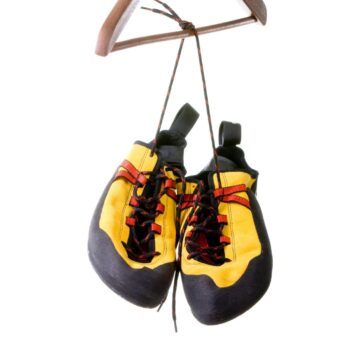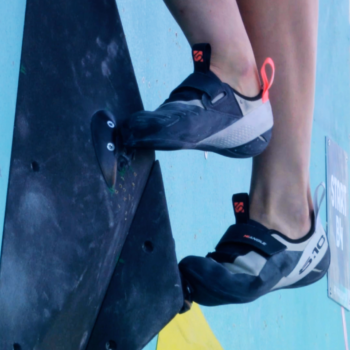The Art of Choosing Climbing Shoes: Finding the Perfect Fit
Table of Contents
Choosing Climbing Shoes
Climbing shoes are a vital piece of equipment for climbers of all levels. However, with the multitude of climbing shoe options available, finding the right pair can be overwhelming and the wrong type of shoe or fit can be the difference between a good climbing day and a bad one.
Choosing climbing shoes doesn’t have to be a headache. Relieve yourself of the stress by taking into consideration these three main points when choosing climbing shoes: the shoe type, fit, and features.
Climbing Shoe Type
Neutral, moderate, and aggressive climbing shoe types refer to the curvature or downturn of the shoe’s toe. This is important to consider when choosing climbing shoes because the curvature affects the shoe’s performance and the climber’s ability to utilize their toes effectively while climbing.

When choosing a climbing shoe type, find the toe shape that aligns with your climbing goals and level of experience. Here’s a breakdown of the differences between these types:
Neutral Climbing Shoes
They have a flat or slightly downturned toe shape, which offers a more relaxed fit. These shoes are more suitable for climbers who prioritize comfort and versatility and are ideal for all-day climbing, long routes, and trad climbing. Ultimately, they are highly recommended for beginners. Looking for your beginner shoe? Check out this video for beginners on how to try out new shoes.
Moderate Climbing Shoes
These shoes have a more pronounced downturn in the toe compared to neutral shoes. This moderate downturn enhances the shoe’s ability to edge and provides better power and precision on small footholds. This makes them better than neutral climbing shoes for technical climbing. Overall, they are more suitable for climbers looking to progress beyond beginner shoes by striking a balance between comfort and performance.
Aggressive Climbing Shoes
Aggressive shoes have a highly downturned toe shape, emphasizing power and precision. This curvature pulls the climber’s toes downward, allowing for maximum force to be applied to small holds and steep overhanging sport climbs. Because of the snug fit and downturned shape, climbers typically wear these shoes for single-pitch sport climbs and routes at the gym rather than all-day multi-pitch climbs.
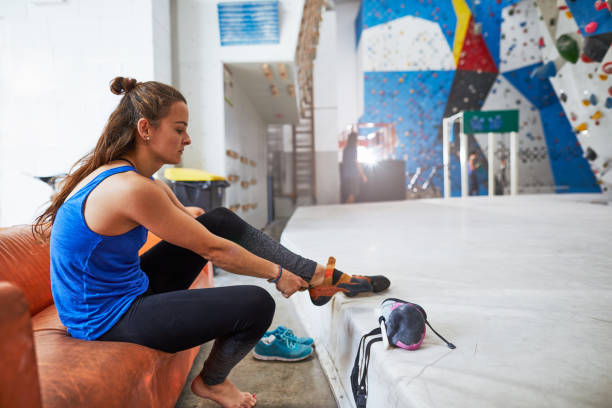
Climbing Shoe Fit
Here are some points to consider about shoe fit:
- Snug Fit: Not everyone has the same foot size and shape. It is important when choosing climbing shoes that you find a shoe that is similar in shape to your foot, so when worn tight it can be equally tight across the whole foot. Tip: It’s not about PAIN! Foot pain will prevent you from climbing and can cause foot injuries. Find a shoe that fits you.
- Size: Climbing shoe sizes can vary across brands and models. It is recommended to try on multiple sizes to find the perfect fit. Keep in mind that climbing shoes often stretch over time, so consider a snugger fit initially. Reminder: The size will also differ depending on whether or not you wear socks while climbing
- Minimal Dead space: Dead space inside the shoe can lead to decreased control and efficiency. Ensure there are no significant gaps or air pockets between your foot and the shoe.
- Toe Placement: It is best to have your toes lay flat or comfortably curved. If your toes are crunched up against the top of the shoe, this can cause serious pain.
- Try Them On At The Store: Ideally, you should go to the shop and try on the climbing shoes in person. Stores that typically sell climbing shoes have a climbing wall which is great for testing out the shoes before you buy them. It is also recommended to shop in the afternoon because your feet can swell up to a full size during the day. Recommend: go for a walk or run before you try on shoes
Climbing Shoe Features
When choosing climbing shoes, it’s crucial to consider various features that can greatly impact your climbing experience. Here are some important climbing shoe features to look for:
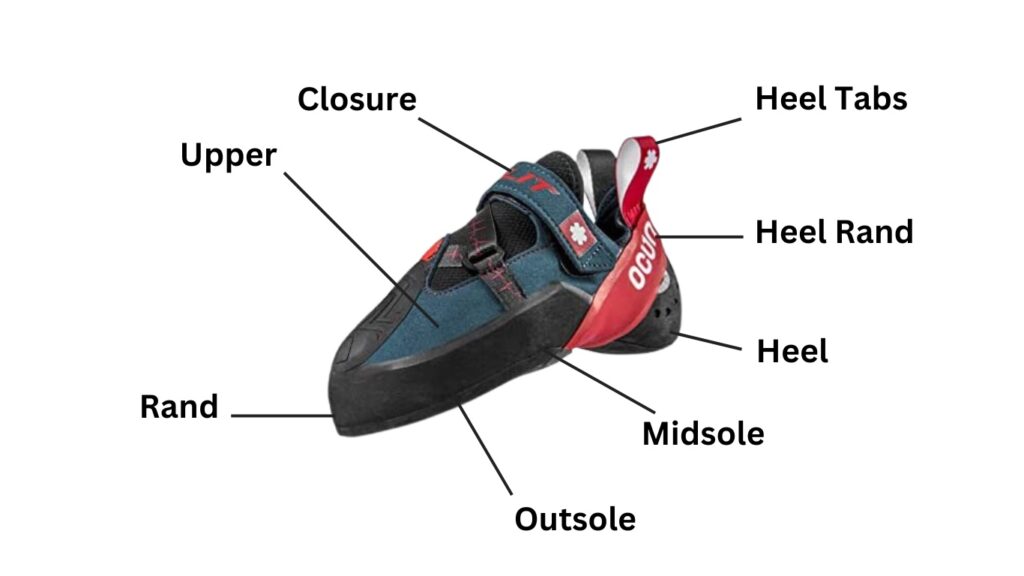
Rubber
The type and thickness of the rubber on the outsole greatly influence a shoe’s grip and durability. Stickier rubber compounds provide better traction on rock surfaces, allowing you to confidently smear and edge. Thicker rubber provides increased durability, making the shoes last longer, especially for climbers who frequently climb outdoors.
Closure Systems
Climbing shoes typically come with three closure systems: lace-up, Velcro, and slip-on. The closure system affects adjustability, convenience, and ease of use. Lace-up shoes offer a precise and customizable fit but may take longer to put on and adjust. Velcro closure systems provide quick and easy on/off functionality and are suitable for gym climbing or bouldering. Slip-on shoes offer convenience and are often used for indoor climbing.
Upper Material
The upper material of climbing shoes can be either leather or synthetic. Leather uppers tend to stretch and mold to the shape of your foot over time, offering a personalized fit. They also tend to be more breathable. Synthetic uppers, on the other hand, are less likely to stretch and maintain their shape longer. They often provide a more precise fit and can be more durable.
Midsole
The midsole is the layer between the outsole and the insole of the shoe. It affects the shoe’s stiffness, which influences sensitivity and support. Softer midsoles offer increased sensitivity, allowing you to feel the rock better, which is useful for smearing and precise foot placements. Stiffer midsoles provide more support for edging on small footholds and vertical climbs. Consider the balance between sensitivity and support based on your climbing style and preferences.
Toe Rand
The toe rand is the rubber reinforcement that covers the front of the shoe, protecting it from abrasion and providing additional friction on toe hooks. Look for climbing shoes with a well-designed and durable toe rand to enhance the longevity of your shoes and improve performance on more technical climbs.
Heel Design
The heel of the shoe plays a significant role in heel hooking, a technique commonly used in bouldering and steep climbing. Look for shoes with a snug-fitting, secure heel that wraps around your foot without excessive dead space. A well-designed heel cup will provide stability and precision during heel hooks.
Breathability
When choosing climbing shoes consider the shoe’s breathability, especially if you climb in hot and humid conditions. Shoes with breathable uppers or perforated designs help to keep your feet cool and prevent excessive sweating, enhancing comfort during long climbing sessions.
Weight
The weight of climbing shoes can affect your performance and endurance, especially during long climbs or when making dynamic moves. Lighter shoes generally allow for better sensitivity and agility. However, it’s essential to strike a balance between weight and other features to ensure the shoes meet your specific climbing needs.
Remember when choosing climbing shoes that the kind of shoe you choose will vary depending on your climbing style, level of experience, and personal preference. Trying on different models and consulting with experienced climbers can help you find the right combination of features that will enhance your climbing performance and comfort.
Interested in learning more about climbing, check out the different types of rock climbing.



